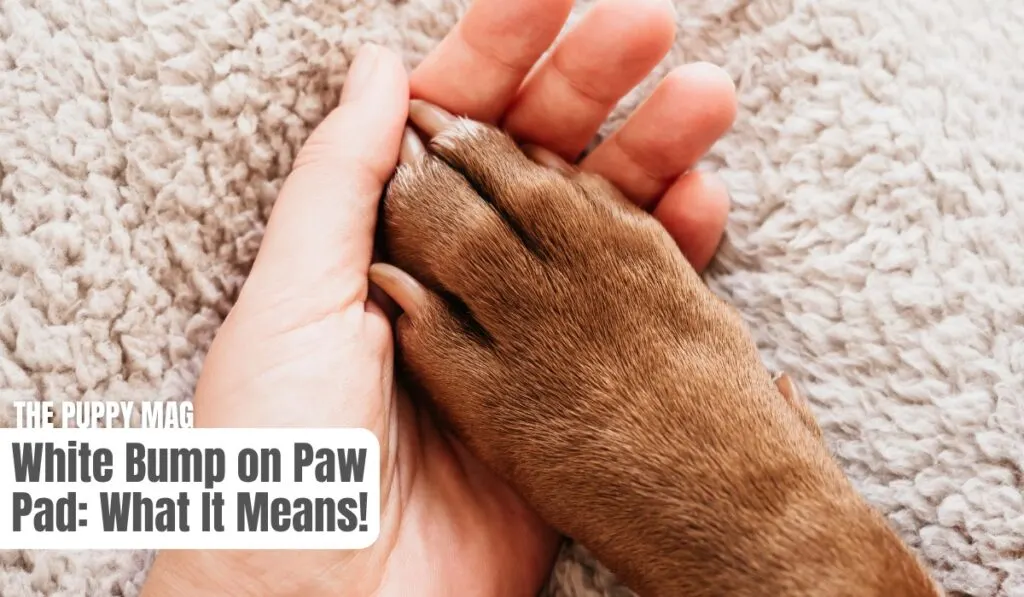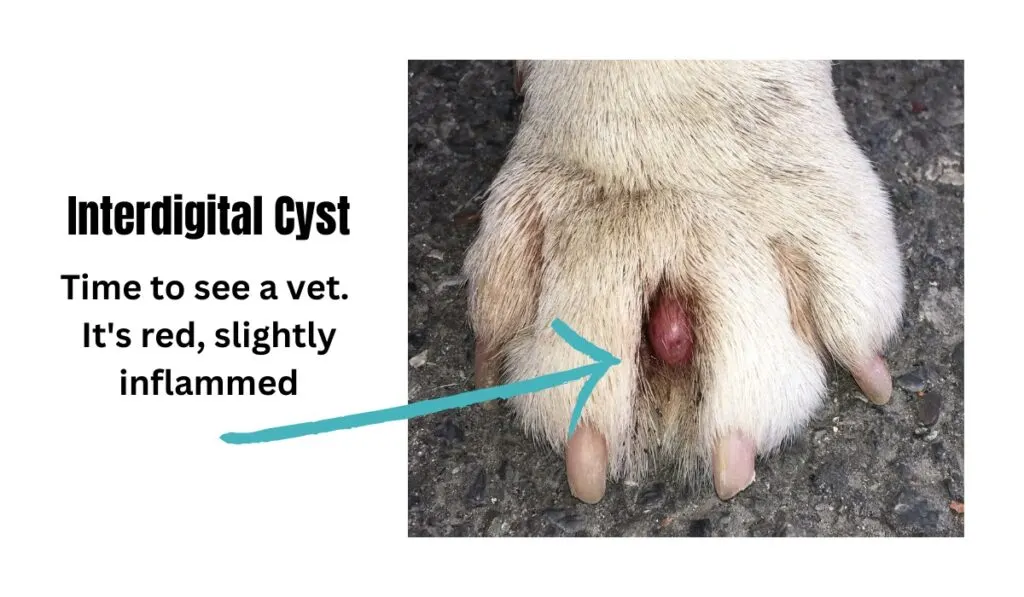If you’ve noticed a white bump on your dog’s paw pad, you might be wondering what could have caused it and how you can help.
This article will explore in depth the possible reasons and what actions should be taken to ensure the wellbeing of your pet.
In this article:
➡️ 8 Causes of White Bumps on a Dog’s Paw Pads
➡️ Is a White Bump Always Something to Worry About
➡️ When It’s a Sign of Something Worse
➡️ Identifying The Cause
➡️ When To See a Vet
➡️ Paw Care Tips & Advice
➡️ FAQS

8 Possible Causes of White Bumps on a Dog’s Paw Pads
Let’s run through the main reasons why you might see a white bump on your dog’s paw.
Below this section we’ll explain whether or not it’s always a sign to worry, and how to identify the cause for your dog.
1. Infections
Infections, both bacterial and fungal, can cause bumps to form on your dog’s paw pads. These organisms can take hold if your dog’s paws become cracked or injured, allowing them to enter and thrive. Bacterial infections often cause redness, swelling, pus-filled bumps, while fungal infections may cause dry, crusty, and white bumps.
2. Foreign body stuck under the skin
If your dog has been exploring outdoors, it’s possible that a small object, such as a thorn, splinter, or piece of glass, has become lodged in their paw pad. This foreign body can trigger your dog’s immune system to react, causing a bump to form around the object.
3. Allergies
Allergies in dogs can manifest in numerous ways, one of which can be skin reactions. These reactions can lead to the formation of bumps, hives, or rashes anywhere on the body, including the paw pads. The allergens may be environmental, such as pollen or dust mites, or they may be found in your dog’s food.
4. Tumors or growths
Although less common, tumors or growths can appear on the paw pads of dogs. These can be benign (harmless) or malignant (cancerous). Usually, these growths are slow to develop, and their size, shape, and color can vary.
5. Cysts
Cysts are sac-like structures filled with fluid, air, or other materials. They can occur anywhere on your dog’s body, including the paw pads. A cyst may appear as a single, rounded bump, and it’s often white or skin-colored.
Interdigital cysts are typically red, not white. If the white bump turns red, then this could be the issue.
Interdigital cysts – Karingal Vet Hospital

6. Corns (Keratoma)
Corns, hard, thickened areas of skin, can develop on a dog’s paw pads due to repetitive pressure or friction. They may look like white bumps and are often painful, causing limping or other changes in the way your dog walks.
More info – Manchester Veterinary Specialists
7. Autoimmune diseases
Certain autoimmune diseases, where the dog’s immune system attacks its own body, can cause changes in the skin, including the formation of bumps on the paw pads. These diseases can be complex and may require thorough veterinary investigation to diagnose.
8. Injuries
Simple injuries such as cuts, scrapes, or burns can lead to a bump forming on your dog’s paw pad. Injuries can become infected, making the situation worse, so it’s important to keep an eye on your dog’s paws if they’ve been injured.
Is a White Bump on The Paw Always a Sign of Concern?
Noticing a white bump on your dog’s paw pad can understandably cause worry. However, it’s important to remember that not every bump spells trouble.
Many causes of these bumps are benign and can resolve on their own or with minimal treatment.
For instance, a minor injury like a scrape or a foreign body like a splinter can lead to a temporary bump. Once the wound heals or the object is removed, the bump should disappear.
Similarly, some cysts may form and resolve spontaneously without causing your pet any significant discomfort.
It’s also crucial to note that even more serious causes, such as tumors, are not always life-threatening. There are many benign (non-cancerous) growths that dogs can develop, and even if a growth is malignant (cancerous), many can be effectively treated with early detection and appropriate veterinary care.
Still, although many cases of this issue are not something to worry about too much, we need to observant and cautious, and be ready to visit the vet should the bump indicate something worse.
Related: Redness Between Your Dog’s Toes: Causes & Solutions
When It Could Indicate Something Worse
While many causes of a white bump on your dog’s paw pad are relatively benign, there are circumstances where the bump could indicate a more serious condition.
The following signs are indicators that your dog’s bump might be more severe, warranting a prompt visit to the vet:
- Rapid growth: If the bump is rapidly growing in size, it could indicate an aggressive form of growth or tumor. Early detection and treatment are crucial in these cases.
- Change in color or texture: Significant changes in the bump’s color, particularly becoming darker, or changes in texture, such as becoming rough or ulcerated, should be a cause for concern.
- Pain: If your dog seems to be in pain when the bump is touched, or they’re limping, this could indicate a serious issue. Signs of pain include whimpering, shaking, changes in behavior, or reluctance to move.
- Excessive licking or chewing: While some licking or chewing is normal, especially if the bump is itchy or uncomfortable, excessive attention to the area could suggest a more serious issue.
- Loss of appetite: If your dog is not eating as they normally would, it could be a sign that they’re not feeling well. While this could be unrelated to the bump, it can also suggest that the bump is part of a more systemic issue.
- Fever, lethargy, or other systemic signs of illness: A bump accompanied by signs of general sickness, like fever or tiredness, could be a sign of a systemic infection or disease.
- Bleeding or discharge: If the bump is bleeding, has an unpleasant odor, or has pus or other discharge, it may be infected or ulcerated. Both require veterinary attention.
It’s important to remember that these signs don’t necessarily mean there’s a catastrophic issue, but they do suggest that your dog needs to be seen by a vet soon.
Identifying The Cause
Determining the cause of a white bump on your dog’s paw pad can be challenging.
Close observation of the bump’s characteristics and your dog’s behavior can provide clues.
For instance, if the bump is painful or itchy, your dog may lick or chew at the paw excessively. This could indicate a recent injury, or an itchy allergic reaction…
A sudden appearance might suggest an injury or foreign body, while a slow-growing bump may suggest a tumor.
Other symptoms like limping, changes in appetite, or changes in behavior can also provide important information.
Ultimately, identifying the cause will involve thinking about the recent events leading up to this moment, how your dog is reacting to the bump, and how long it’s been there for.
When To See a Vet & What Will They Do
If your dog’s bump is causing them distress or isn’t getting better, it’s time to see the vet. Your vet will likely examine the bump and ask you about its history.
They may take a sample from the bump to look at under a microscope or send to a lab for further testing.
This can help determine if it’s an infection, a tumor, or another cause.
If the bump is due to a foreign object, your vet may need to remove it.
In cases of allergies, cysts, corns, or autoimmune diseases, different treatments will be necessary, including possible medications, dietary changes, or even surgery.
Paw Care Tips & Advice
Keeping your dog’s paws healthy can prevent some causes of white bumps.
- Regularly check your dog’s paw pads for cuts, scrapes, or foreign bodies.
- Wash their paws gently after walks, especially if they’ve been walking on rough terrain or in dirty areas.
- Use pet-friendly moisturizers if your dog’s paw pads are dry and prone to cracking.
- Provide a balanced diet to support overall skin health and reduce the risk of allergies.
Even just applying those basic four practices listed above will ensure your dog’s paws are kept in 99.9% better condition than most other pups out there.
Unfortunately, paw care is something us owners need to take more seriously!
I recently asked all of my family and friends about the last time they gave their pup a puppy-pedicure. And you guessed it, it’s never happened.
Paw Care Tips – Preventive Vet
FAQs
Q: Can I treat a white bump on my dog’s paw at home?
A: While minor injuries can often be managed at home with cleaning and monitoring, it’s important to seek veterinary advice if you’re unsure of the cause, or if the bump is causing your dog distress or doesn’t improve.
Q: Will the white bump on my dog’s paw go away on its own?
A: This largely depends on the cause. Some bumps, like those caused by minor injuries or certain types of cysts, may resolve on their own. Others, such as those due to allergies, autoimmune diseases, or tumors, will require veterinary treatment.
Summary
White bumps on a dog’s paw pads can have a variety of causes, from minor injuries and foreign bodies to allergies, infections, and more serious conditions like tumors or autoimmune diseases.
Knowing when to be concerned and when to seek veterinary help is key to ensuring your dog’s health and wellbeing.
Regular paw care can also help prevent some of these issues.
Always consult your vet if you’re unsure or worried about a bump on your dog’s paw. Remember, it’s better to be safe than sorry when it comes to your furry friend’s health.
